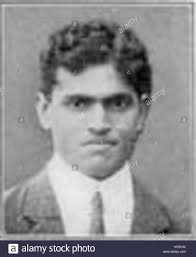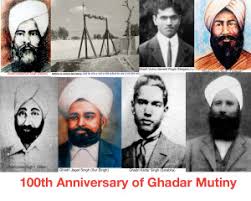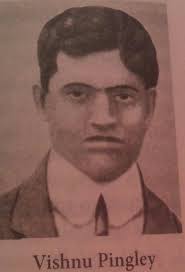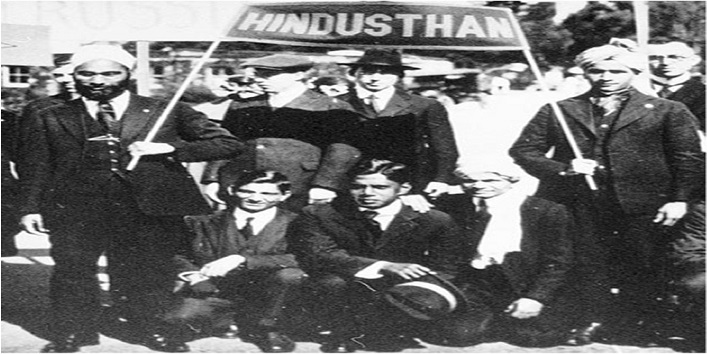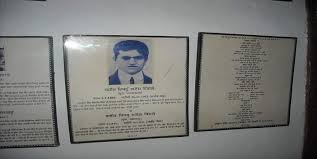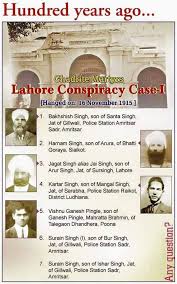On his Jayanti, let’s remember the sacrifice of #VishnuGaneshPingle, who gave his life for Maa Bharati at the ripe age of 27.
Let me also remind Congress & Communists that, while they were in cohorts with British, here was One of 100s of Savarkarites who happily gave up their
Let me also remind Congress & Communists that, while they were in cohorts with British, here was One of 100s of Savarkarites who happily gave up their
life for a cause – Freedom Of India.
Vishnu Ganesh Pingle was born on 2 January 1888 to a Marathi Brahmin family Talegaon Dhamdhere, near Poona District. The youngest of nine siblings, Pingle grew up in a loving family and at the age of nine was admitted to the primary school
Vishnu Ganesh Pingle was born on 2 January 1888 to a Marathi Brahmin family Talegaon Dhamdhere, near Poona District. The youngest of nine siblings, Pingle grew up in a loving family and at the age of nine was admitted to the primary school
in Talegaon Dabhade. While at school, Pingle came under the influence of the nationalist movement of the time, and actively participated in the movement under V. D. Savarkar and this early involvement in the nationalist movement left a lasting imprint.
In 1910, Vishnu left for
In 1910, Vishnu left for
Mumbai and found employment in Govindrao Potdar's Pioneer Alkali works at Mahim. Mr. Potdar was a nationalist and an expert at explosives. He belonged to the Nationalist Group and introduced Vishnu to his associates. One of them was Hari Laxman Patil, a lawyer from Vasai, with
whom Vishnu came to form a close friendship. At the height of the Swadeshi Movement, inspired by the Japanese handloom industry, Pingle began his own small Swadeshi loom at Ausa, near Latur. However, Pingle's ambition was to be an engineer.
In 1911, Pingle left Ausa for the
In 1911, Pingle left Ausa for the
United States. It is said that he kept the news of his impending departure from his family and only told his elder brother Keshavrao of his plans at the railway station. He reached America via Hong Kong, and enrolled as a student of mechanical engineering at the University of
Washington in 1912. While in the United States, Pingle became associated with the Ghadar Party and became an active worker. As World War I opened in Europe, plans began between the Germans, the Berlin Committee in Europe and the Ghadarite movement in America to attempt an
insurrection in India.
Pingle had known Satyen Bhushan Sen (Jatin Mukherjee's emissary) in the company of Gadhar members (such as Kartar Singh Sarabha) at the University of California, Berkeley. Tasked to consolidate contact with the Indian revolutionary movement, as part of
Pingle had known Satyen Bhushan Sen (Jatin Mukherjee's emissary) in the company of Gadhar members (such as Kartar Singh Sarabha) at the University of California, Berkeley. Tasked to consolidate contact with the Indian revolutionary movement, as part of
the Ghadar Conspiracy, Satyen Bhushan Sen, Kartar Singh Sarabha, V.G. Pingle and a batch of Sikh revolutionaries sailed from America by the S. S. Salamin in the second half of October 1914. Satyen and Pingle halted in China for a few days to meet the Gadhar leaders
(mainly Tahal Singh) for future plans. They met Dr Sun Yat-Sen for co-operation. Dr Sun was not prepared to displease the British.
In November 1914, Pingle, Kartar Singh and Satyen Sen arrived in Calcutta. Satyen introduced Pingle and Kartar Singh to Jatin Mukherjee.
In November 1914, Pingle, Kartar Singh and Satyen Sen arrived in Calcutta. Satyen introduced Pingle and Kartar Singh to Jatin Mukherjee.
"Pingle had long talks with Jatin Mukherjee, who sent them to Rash Behari" in Benares with necessary information during the third week of December.
In Nov 1914, Pingle visited Rash Bihari with a letter from Jatin Mukherjee and reported that some 4,000 Sikhs of the Ghadar had
In Nov 1914, Pingle visited Rash Bihari with a letter from Jatin Mukherjee and reported that some 4,000 Sikhs of the Ghadar had
already reached Calcutta. 15,000 more were waiting to come and join the rebellion. Behari sent Pingle &Sachin Sanyal to Amritsar, to discuss with Mula Singh who had come from Shanghai. Rash Behari's man of confidence, Pingle led a hectic life in UP and Punjab for several weeks.
Along with Rash Behari Bose, Sachin Sanyal and Kartar Singh, Pingle became one of the main coordinators of the attempted mutiny in February 1915. Under Rash Behari, Pingle issued intensive propaganda for revolution from December 1914, sometimes disguised as Shyamlal, a Bengali;
sometimes Ganpat Singh, a Punjabi.
Confident of being able to rally the Indian sepoy, the plot for the mutiny took its final shape. The 23rd Cavalry in Punjab was to seize weapons and kill their officers while on roll call on 21 February. This was to be followed by mutiny in
Confident of being able to rally the Indian sepoy, the plot for the mutiny took its final shape. The 23rd Cavalry in Punjab was to seize weapons and kill their officers while on roll call on 21 February. This was to be followed by mutiny in
the 26th Punjab, which was to be the signal for the uprising to begin, resulting in an advance on Delhi and Lahore. The Bengal revolutionaries contacted the Sikh troops stationed at Dacca through letters of introduction sent by Sikh soldiers of Lahore, and succeeded in winning
them over.
However, the Punjab CID successfully infiltrated the conspiracy at the last moment through Kirpal Singh: a cousin of the trooper Balwant Singh (23rd Cavalry), US-returned Kirpal, a spy, visited Rash Behari's Lahore headquarters near the Mochi Gate, where over a dozen
However, the Punjab CID successfully infiltrated the conspiracy at the last moment through Kirpal Singh: a cousin of the trooper Balwant Singh (23rd Cavalry), US-returned Kirpal, a spy, visited Rash Behari's Lahore headquarters near the Mochi Gate, where over a dozen
leaders including Pingle met on 15 February 1915. Kirpal informed the police.
Plans for revolt by the 130th Baluchi Regiment at Rangoon on 21 Feb were thwarted. Attempted revolts in the 26th Punjab, 7th Rajput, 130th Baluch, 24th Jat Artillery & other regiments were suppressed
Plans for revolt by the 130th Baluchi Regiment at Rangoon on 21 Feb were thwarted. Attempted revolts in the 26th Punjab, 7th Rajput, 130th Baluch, 24th Jat Artillery & other regiments were suppressed
Mutinies in Firozpur, Lahore, and Agra were also suppressed and many key leaders of the conspiracy were arrested, although some managed to escape or evade arrest. A last-ditch attempt was made by Kartar Singh and Pingle to trigger a mutiny in the 12th Cavalry regiment at Meerut.
Kartar Singh escaped from Lahore, but was arrested in Benares & V. G. Pingle was apprehended from the lines of the 12th Cavalry at Meerut, in the night of 23 March 1915. He carried "ten bombs of the pattern used in the attempt to assassinate Lord Hardinge in Delhi," according to
Mumbai police report. It is said that it was enough to blow up an entire regiment.
Mass arrests followed as the Ghadarites were rounded up in Punjab and the Central Provinces. Rash Behari Bose escaped from Lahore and in May 1915 fled to Japan. Other leaders, including Giani
Mass arrests followed as the Ghadarites were rounded up in Punjab and the Central Provinces. Rash Behari Bose escaped from Lahore and in May 1915 fled to Japan. Other leaders, including Giani
Pritam Singh, Swami Satyananda Puri and others fled to Thailand or other sympathetic nations.
Vishnu Ganesh Pingle and a number of other Ghadarites including Kartar Singh Sarabha, Harnam Singh and Bhai Paramanand were tried in the Lahore Conspiracy trial in April 1915 by a
Vishnu Ganesh Pingle and a number of other Ghadarites including Kartar Singh Sarabha, Harnam Singh and Bhai Paramanand were tried in the Lahore Conspiracy trial in April 1915 by a
special tribunal constituted under the Defence of India Act 1915, for their roles in the February plot. Pingle was executed by hanging at the Lahore Central Jail on 16 November 1915, along with Kartar Singh.
This hero doesn’t even have a stamp in his name and ironically, his
This hero doesn’t even have a stamp in his name and ironically, his
grand-daughter @rajanipatil_in is in @incindia for decades, as a Loksabha member in 1996 and Rajya Sabha in 2013.
She is currently the All India Congress Committee In-charge for J&K.
I think this sums up the despicable life of a slave.
I have nothing more to add.
#VANDEMATARAM
She is currently the All India Congress Committee In-charge for J&K.
I think this sums up the despicable life of a slave.
I have nothing more to add.
#VANDEMATARAM

 Read on Twitter
Read on Twitter